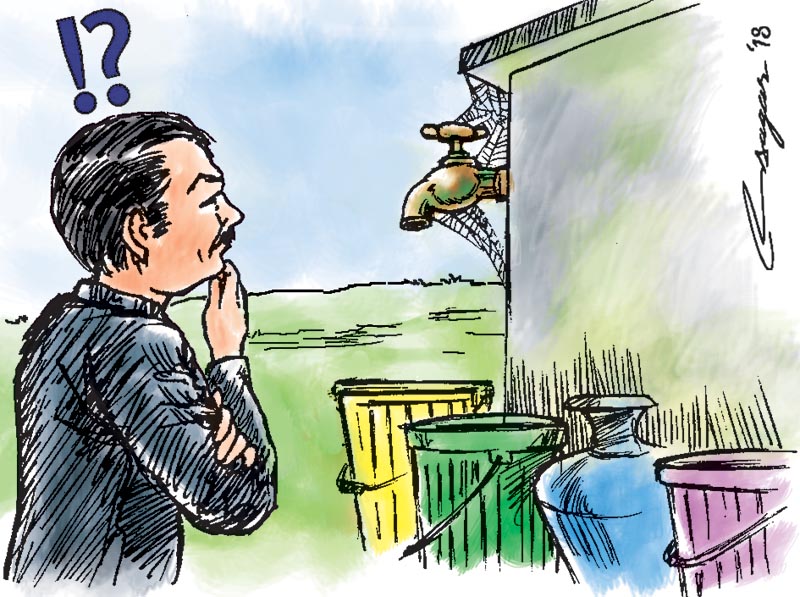Water from Melamchi: When will it arrive?
A lot of water has flowed down the Melamchi since the water project was announced in 2001. Though it is said that Kathmandu will get water from Melamchi by this Dashain, the pace of work presents a bit dismal picture
Water from Melamchi River to quench the thirst of Kathmanduites was a dream project of the late Krishna Prasad Bhattarai who made “abundant water for the Capital” his election campaign in 1995. But he lost the election. Bhattarai had become the prime minister following the restoration of democracy in 1990 and served for 402 days.
The Melamchi dream, however, continued, and many elections were fought with the promise to bring water to the Capital from the river in Sindhupalchowk. Melamchi simply made a very attractive election slogan, for Kathmandu’s chronic water shortage was a perennial problem. Sadly, water crisis still continues even two decades later. Valley residents are still not sure when they are going to get water from Melamchi on their taps.
The Melamchi Drinking Water Project saw its formal inauguration in 1998. After funding arrangement in 2001, the project completion deadline was set for December 2013. But missing deadlines have been the order of the day in Nepal. Several governments came, set a new deadline and went. Melamchi water never arrived.
The new government now in place too has announced that Valley people would get Melamchi water by this Dashain. But the sluggish pace of work is anything to go by it looks like this Dashain too would pass without Melamchi water. A site engineer says it could take two more years, given the pace of the work, to complete the project.
The news of tunnel breakthrough in April this year brought optimism about the timely completion of the project. But that’s just one of the segments in the mammoth task of bringing water from Melamchi to Kathmandu. The remaining works are deadly slow, as it had been in the past.
If we take 2001 as the marking year for the project, in the last 17 years the tunnel drilling speed was about 1.5 kilometres a year or four metres a day.
Now the tunnel needs to be cemented and finished, for which the work is progressing with an average speed of 30 metres per day. This pace will mean it will take around two more years to complete the 21-km tunnel.
That aside, there are lots of other works that have to be carried out side by side. Pipeline works in various parts of the Valley are yet to be completed while reservoir construction is yet to be finished.
On top of this, the Italian contractor CMC di-Ravenna, has now claimed Rs 1.65 billion from the government in compensation for the losses due to the earthquakes and strikes. This is set to cause further delay.
The initial cost of Melamchi project was US$ 464 million at 2000 prices. The cost now is about Rs 34 billion. This single project is thus about 11 per cent of the current national development budget. If other components are augmented – that is adding water from Yangri and Larkey rivers – the cost is set to go through the roof.
Ultimately, the increased cost of drinking water is to be paid by consumers. The Kathmandu Upatyaka Khanepani Limited (KUKL) has already increased the water tariff several times since 2008. It has announced that the tariff in the Kathmandu Valley will be hiked by 27 per cent every year.
The other bad consequence of the Melamchi project is road demolition and dust pollution. In the past two years or so, many new and black-topped roads and footpaths have been dug up by for laying water pipelines. But the heaps of rubble were neither cleared. Nor were the roads and footpaths reconstructed properly, adding to the woes of commuters.
Though not adequately established, some critics have alleged that there has been some sinister link between the KUKL and private water supplying agencies for the delay in the completion of the Melamchi project. This cannot be ruled out in a country like Nepal where recently the nexus between the electricity office officials and inverter suppliers was exposed. The country was reeling under up to 20 hours of load-shedding until few months ago.
The fact, however, remains that the Kathmandu Valley is short of 210 million litres of water per day. This gap is filled by private water suppliers.
A rough estimate of an 8,000-litre water tanker, which costs Rs 1,500, will produce a whopping Rs 39 million per day. So some believe a delayed Melamchi project will keep these water suppliers’ profit safe.
A recent study conducted by Nepal Academy of Science and Technology found that 79 per cent of all bottled, jar and tanker water was infected with coliform bacteria. This means water from these suppliers poses a serious health hazard to Kathmandu population.
Also, the delay in completion of the Melamchi project directly benefits some white collar job holders, who draw huge amounts of money in the form of salary and perks. Project extension also allows the contractor to demand variation cost.
The sluggish work and additional costs have made Melamchi one of the costliest projects ever in the country. Mismanagement and cost burden of Melamchi is a serious issue.
The fundamental questions re: Will this water project in which millions of rupees have been pumped would be able to quench the thirst of denizens of the Valley? And when?
Satyal is a professor at Department of Statistics, Tribhuvan University






